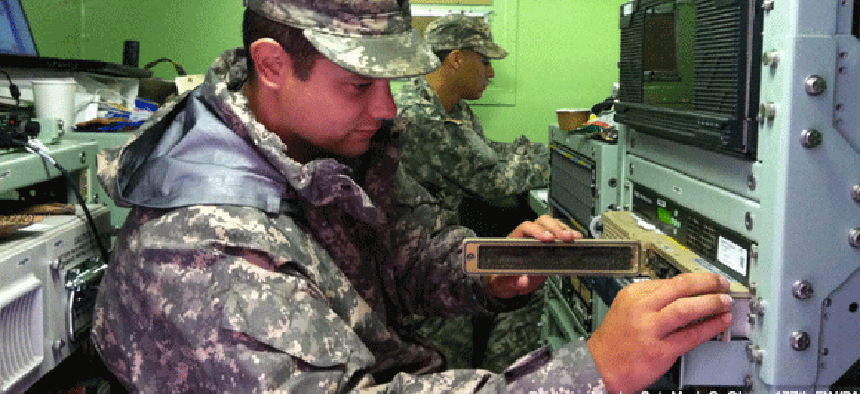Wisconsin Guard eliminates data centers, but keeps its services


Connecting state and local government leaders
By using Riverbed storage appliances, the state’s National Guard serves up files from a central command while leaving the WAN free for other tasks.
The United States is a big place. Some individual states are larger than entire European countries. But although size has many advantages, it also can present challenges for government agencies tasked with serving communities hundreds or even thousands of miles away from a central location, as well as apart from each other.
The way most agencies work across vast distances is to create lots of branch offices where citizens can go to get services, or where government employees can report for work before serving their local communities. There is usually a central hub or headquarters building too, but the branch offices typically have computers, servers and even their own data centers to serve their needs.
Wisconsin knows the challenges associated with geography. One of the most beautiful states, it encompasses over 65,000 square miles of territory along the banks of the Great Lakes. As the 26th largest state, it’s right in the middle in terms of size.
The Wisconsin Army National Guard is charged with protecting every square inch of the state from threats, and responding to help citizens dealing with natural disasters or other emergencies. Its territory ranges from the Apostle Islands Maritime State Forest deep in the cold northern waters of Lake Superior down to the sprawling industrial city of Milwaukee along the shore of Lake Michigan in the south.
The Guard provides a perfect example of the concept of branch locations. It maintains 70 remote sites and armories across the state, which also means 70 sites connected to its network.
"Even in the woods, we are network dependent," Guard Lt. Col. Jeff Alston said. "The network is a strategic asset."
Alston spoke from his command tent during a week when he was busy running statewide training maneuvers, chatting as soldiers on maneuvers marched by outside, or stopped in to obtain new orders. Alston said his command tent, which is filled with LCD monitors and computers, showed why, even at a remote location, network connectivity is important.
With such heavy reliance on network connectivity, the Guard set up servers and data centers at most of its armories and remote locations. Generally this was done by adding a T1 line for connectivity, and then a server to address the needs of the local troops, or even a full data center at larger locations. All data backups and IT services were provided on site by local IT administrators.
Now the Guard, along with the state, is trying something new. The Guard has eliminated data centers, servers and support services at 10 of its largest armories, replacing them with Riverbed appliances that provide everything soldiers need while also freeing up WAN resources, and without requiring local support.
The Riverbed solution is divided up into two parts, and two types of appliances, company officials said. The first is the Granite Core appliance, which, as the name suggests, sits at the main agency data center. The second is the Granite Edge appliance, which serves individual branch offices.
The technology removes computational level commands from the core storage assets. Instead of working with programs over the WAN from a remote office, as in the case of a pure thin client type of solution, the Edge appliance serves local users the files they most often need. But unlike having a full data center or server locally, all of the data is actually still stored at the central office.
The appliances use deduplication to make sure that users at remote offices have instant access to files they use frequently. The Granite Core analyzes Edge users and sends unique byte patterns over the WAN as needed. Redundant data is replaced with a reference identifying it as such, so that it never has to be resent. The Edge then updates files that are modified or changed back to the Granite Core, sending only what is needed so that local users have a complete working copy, and the headquarters data center retains all of the actual information.
For the Wisconsin Guard, the savings come not just from eliminating servers and support at the local armories, but also from a reduced need for super-fast, high broadband WAN support, according to Alston.
That performance and bandwidth can then be used for other things. Increasing the state's WAN performance is important, Alston said, because more content and content types are constantly being added. "Wisconsin is always adding new stuff online like video," he said. "So we need the WAN to be as good as possible."
Another advantage to the Riverbed configuration is that even though branch offices have quick access to all of their files and data, including using boot-over-WAN technology, everything is actually completely stored in the main data center. For Wisconsin, that means there is no need to perform backups at each branch location that is served by an Edge appliance. Instead, backups can be made at the central office. Also, the IT staff can provision, manage, upgrade and patch servers for the branch locations from the secure data center instantly without having to travel across the state.
Although the Wisconsin Army National Guard has 10 of its largest armories set up with Edge appliances, Alston would like to deploy the solution to some of the remaining 60 locations under his command, getting it down into some of the smaller and more remote sites at the edges of the state. Not only will that further optimize Wisconsin's WAN, but also put everyone on equal footing, Alston said.
Editor’s note: The Wisconsin Army National Guard said the views expressed in this story do not represent an official endorsement of the Riverbed appliance or any particular product or solution provider.




